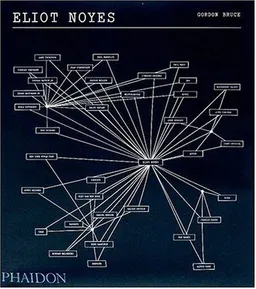First Major Monograph on the Man Responsible for Permanently Revolutionizing Design in Corporate America; First Director of Industrial Design at MoMA.
"Why isn't Eliot Noyes as famous as his friends? . . . Contemporary articles on Noyes emphasize his charm, stability, and conservatism to explain why even then he was not better known, as well as how he achieved so much power in the corporate hierarchy." Metropolis Magazine
Who was Eliot Noyes (1910-77)? Architect? Industrial Designer? The first Director of MoMA's Department of Industrial Design? Pioneering businessman? Noyes's credits include all of the above, but the reality is that this founding member of "The Harvard Five" is an under known icon. His legacy includes a vast web of connections linking influential figures, such as Marcel Breuer, Charles and Ray Eames, Alexander Calder, and Paul Rand, to influential corporations, including IBM, Westinghouse, and Mobil. At the epicentre of all these famous names sits a genius who permanently changed the role of design and architecture in corporate America.
ELIOT NOYES by Gordon Bruce, is the first book to explore the unique architect, designer, and businessman's life and work. This ground-breaking monograph combines lively text with archival and new color photography, rare drawings, plans and a diverse range of documentary material--much of which is previously unpublished.
Part of a larger reawakening of interest in the architect's work, the book appears at the climax of the debate of the fate of the award-winning Noyes family residence in Connecticut. Noyes attracted fellow members of the Harvard Five to New Canaan by building his first modern house there in 1947. Yet, while Philip Johnson's Glass House is now a National Trust Historic site, the future of the Noyes' home is unknown.
Eliot Noyes fused architecture, art, interiors, products, and graphics to construct a unique corporate style. He was personally responsible for the design of some notable twentieth-century classics, notably IBM's Selectric typewriter and Mobil Oil's service stations and gas pumps. His belief in a unified theory of design, where all elements--large and small--are connected and expressed in the best possible way reconstructed America's corporate attitude towards design forever. His architectural and design principles were about a way of life, not simply a professional attitude. Eliot Noyes used to say, `Design is a means by which you see yourself and a means by which you express yourself to others.'
After graduating from Harvard's School of Design, Noyes began his career as an architect working in the office of Marcel Breuer and Walter Gropius. Gropius's recommendation secured Noyes the position as the first Director of the Industrial Design department at MoMA in the 1940s. At MoMA he organized a now famous competition to discover imaginative new designs for contemporary furniture. And, so began his lifetime commitment to launching the careers of young designers, and ultimately resulting in a chain reaction that ended with the invention of Eero Saarinen's "Womb" chair and Eames's plywood chairs.
After the MoMA, Noyes focused on design consulting for major U.S. companies. From the late 1950s until his death in 1977, Noyes was Consulting Director of Design for IBM, Mobil Oil, Westinghouse and Cummins Engine Company, while working with a myriad of other firms. Re-designing entire product lines, he focused on how all the individual parts, from the buildings to the offices to the graphic design, contributed in completing the total package and ultimately expressing the company's significance and direction. Enlisting pioneering designers and prominent architects, such as Ivan Chermayeff, Tom Geismar, Gordon Bunshaft, and Paul Rudolph, while running his own office of architecture and industrial design, he was the man responsible for changing the way corporations think about design and its impact on business.
The publication of ELIOT NOYES finally gives Noyes his much deserved moment. It's an essential book for any student of architecture, design, or business or those fascinated by the history of design's role in the corporate world.









